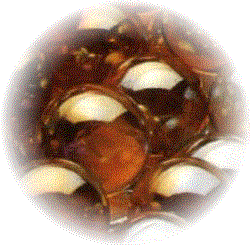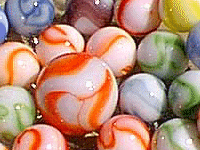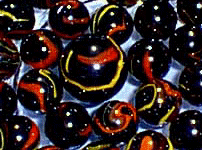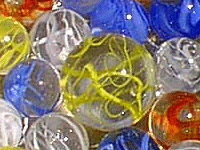Machine-Made Glass Marbles
 The Navarre Glass Marble and Specialty Company in 1897 made handmade
glass marbles, but this original factory soon failed and the owners
moved to Steubenville, Ohio, where they hand produced marbles until
1902. M.F. Christensen invented the first marble machine and, along
with his son, organized a new company in 1901. They hired some of the
Navarre workers from the Navarre Glass and Specialty Company.
The Navarre Glass Marble and Specialty Company in 1897 made handmade
glass marbles, but this original factory soon failed and the owners
moved to Steubenville, Ohio, where they hand produced marbles until
1902. M.F. Christensen invented the first marble machine and, along
with his son, organized a new company in 1901. They hired some of the
Navarre workers from the Navarre Glass and Specialty Company.
 The machine invented by Christensen was quite crude consisting of
grooved cast iron sheaves to form gobs of molten glass into marbles.
Beginning aroung 1905, the partially automatic marble machine produced
enough in quantity to create successful competition with the handmade
foreign imports. In 1911, Akro Agate was formed by Christensen, Randin,
Marsh, and a financial backer named Hill, and in 1914 Christensen pulled
out. Also in 1914, Clinton F. Isreal, a young inventor with Akro Agate,
greatly improved the original machine to make it more fully automatic.
With, much work still to be done by hand to form marbles, Israel
completely reworked the machine in 1926 to make it fully automatic.
The machine invented by Christensen was quite crude consisting of
grooved cast iron sheaves to form gobs of molten glass into marbles.
Beginning aroung 1905, the partially automatic marble machine produced
enough in quantity to create successful competition with the handmade
foreign imports. In 1911, Akro Agate was formed by Christensen, Randin,
Marsh, and a financial backer named Hill, and in 1914 Christensen pulled
out. Also in 1914, Clinton F. Isreal, a young inventor with Akro Agate,
greatly improved the original machine to make it more fully automatic.
With, much work still to be done by hand to form marbles, Israel
completely reworked the machine in 1926 to make it fully automatic.
 This is the type of machine still used today. It consists of a feeding
mechanism for the globes of glass and two metal cylinders, with helical
grooves, which are positioned next to one another rotating in opposite
directions. Hot ball of glass spin between the two cylinders as they
travel along the grooves, falling, still hot and glowing, into a pail
at the other end of the rollers. An almost identical machine was
invented by S.H. Peltier at his glass factory in Ottawa, Illinois, a
couple of years earlier. This resulted in patent suit of Peltier by
Akro Agate, which dragged on for many years in the courts. A machine
much like the original is still used by the Peltier glass factory to
produces marbles today.
This is the type of machine still used today. It consists of a feeding
mechanism for the globes of glass and two metal cylinders, with helical
grooves, which are positioned next to one another rotating in opposite
directions. Hot ball of glass spin between the two cylinders as they
travel along the grooves, falling, still hot and glowing, into a pail
at the other end of the rollers. An almost identical machine was
invented by S.H. Peltier at his glass factory in Ottawa, Illinois, a
couple of years earlier. This resulted in patent suit of Peltier by
Akro Agate, which dragged on for many years in the courts. A machine
much like the original is still used by the Peltier glass factory to
produces marbles today.
 In early 20th century catalogs, the first machine-made glass marbles
were sold. These are classified as imitation agates, most containing
some red. Often the glass was red with white swirls and loops decorating
them. Others were made of clear glass with red, green, white, and/or
blue coloring added to create the various patterns. Some were an opaque
color, perhaps green, with surface swirls of red or orange.
In early 20th century catalogs, the first machine-made glass marbles
were sold. These are classified as imitation agates, most containing
some red. Often the glass was red with white swirls and loops decorating
them. Others were made of clear glass with red, green, white, and/or
blue coloring added to create the various patterns. Some were an opaque
color, perhaps green, with surface swirls of red or orange.
Peltier Glass Factory in Ottawa manufactured 5/8" cerise agates under the
name of M. Gropper and Sons, Inc., distributor for the Peltier factory.
These agates, in the original box, can be traced to 1926, and are of red
colored glass with white swirls throughout.
|



 The Navarre Glass Marble and Specialty Company in 1897 made handmade
glass marbles, but this original factory soon failed and the owners
moved to Steubenville, Ohio, where they hand produced marbles until
1902. M.F. Christensen invented the first marble machine and, along
with his son, organized a new company in 1901. They hired some of the
Navarre workers from the Navarre Glass and Specialty Company.
The Navarre Glass Marble and Specialty Company in 1897 made handmade
glass marbles, but this original factory soon failed and the owners
moved to Steubenville, Ohio, where they hand produced marbles until
1902. M.F. Christensen invented the first marble machine and, along
with his son, organized a new company in 1901. They hired some of the
Navarre workers from the Navarre Glass and Specialty Company. The machine invented by Christensen was quite crude consisting of
grooved cast iron sheaves to form gobs of molten glass into marbles.
Beginning aroung 1905, the partially automatic marble machine produced
enough in quantity to create successful competition with the handmade
foreign imports. In 1911, Akro Agate was formed by Christensen, Randin,
Marsh, and a financial backer named Hill, and in 1914 Christensen pulled
out. Also in 1914, Clinton F. Isreal, a young inventor with Akro Agate,
greatly improved the original machine to make it more fully automatic.
With, much work still to be done by hand to form marbles, Israel
completely reworked the machine in 1926 to make it fully automatic.
The machine invented by Christensen was quite crude consisting of
grooved cast iron sheaves to form gobs of molten glass into marbles.
Beginning aroung 1905, the partially automatic marble machine produced
enough in quantity to create successful competition with the handmade
foreign imports. In 1911, Akro Agate was formed by Christensen, Randin,
Marsh, and a financial backer named Hill, and in 1914 Christensen pulled
out. Also in 1914, Clinton F. Isreal, a young inventor with Akro Agate,
greatly improved the original machine to make it more fully automatic.
With, much work still to be done by hand to form marbles, Israel
completely reworked the machine in 1926 to make it fully automatic.  This is the type of machine still used today. It consists of a feeding
mechanism for the globes of glass and two metal cylinders, with helical
grooves, which are positioned next to one another rotating in opposite
directions. Hot ball of glass spin between the two cylinders as they
travel along the grooves, falling, still hot and glowing, into a pail
at the other end of the rollers. An almost identical machine was
invented by S.H. Peltier at his glass factory in Ottawa, Illinois, a
couple of years earlier. This resulted in patent suit of Peltier by
Akro Agate, which dragged on for many years in the courts. A machine
much like the original is still used by the Peltier glass factory to
produces marbles today.
This is the type of machine still used today. It consists of a feeding
mechanism for the globes of glass and two metal cylinders, with helical
grooves, which are positioned next to one another rotating in opposite
directions. Hot ball of glass spin between the two cylinders as they
travel along the grooves, falling, still hot and glowing, into a pail
at the other end of the rollers. An almost identical machine was
invented by S.H. Peltier at his glass factory in Ottawa, Illinois, a
couple of years earlier. This resulted in patent suit of Peltier by
Akro Agate, which dragged on for many years in the courts. A machine
much like the original is still used by the Peltier glass factory to
produces marbles today. In early 20th century catalogs, the first machine-made glass marbles
were sold. These are classified as imitation agates, most containing
some red. Often the glass was red with white swirls and loops decorating
them. Others were made of clear glass with red, green, white, and/or
blue coloring added to create the various patterns. Some were an opaque
color, perhaps green, with surface swirls of red or orange.
In early 20th century catalogs, the first machine-made glass marbles
were sold. These are classified as imitation agates, most containing
some red. Often the glass was red with white swirls and loops decorating
them. Others were made of clear glass with red, green, white, and/or
blue coloring added to create the various patterns. Some were an opaque
color, perhaps green, with surface swirls of red or orange.